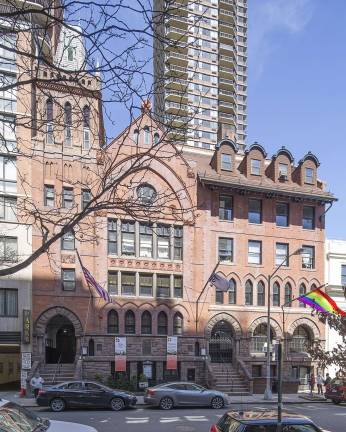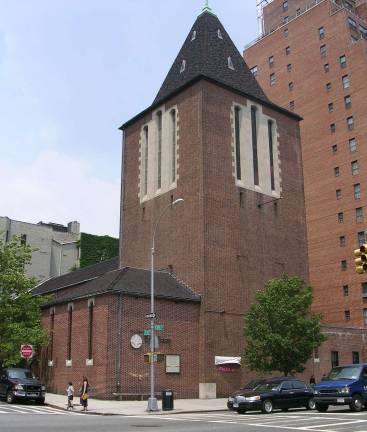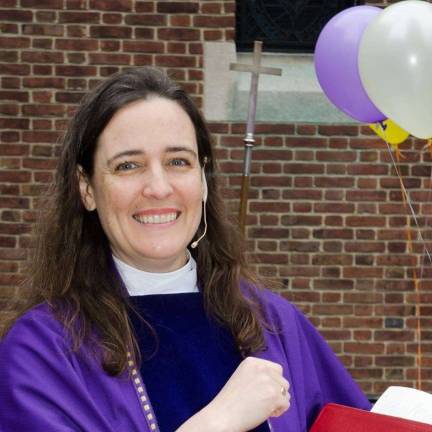Sold: two fabled ues churches



BY DOUGLAS FEIDEN
Jan Hus Presbyterian Church — a storied house of worship on the Upper East Side that once boasted thousands of Czech parishioners — is selling its 1888 building on East 74th Street, Straus News has learned.
“We’re relieving ourselves of a burdensome asset,” said Rev. Beverly Dempsey, the senior pastor. “We’re giving ourselves the opportunity to serve the most vulnerable populations of New York City for generations to come.”
The Church of the Epiphany — built in 1939 to minister to the nearby hospitals and the only place of prayer on York Avenue — is buying Jan Hus, which sits one block to the east, pastors and lay leaders of both congregations confirmed.
“Our building doesn’t work for us, we don’t have enough space, we’re not accessible,” said Rev. Jennifer Reddall. “Now, we’ll be able to significantly expand our ministry to the neighborhood, and at the same time, we’ll get to save a historic building.”
A third venerable local institution — which also has a healing mission, and boasts a far richer endowment — is making the twin transactions possible: Weill Cornell Medicine, which includes a graduate school and a medical school that traces its origins to 1898, is buying Epiphany, the church told worshippers in a Nov. 13 “Dear Friends” letter.
“This is a transformational transaction,” the letter says.
It describes the goal of Epiphany’s vestry, which is made up of its elected lay leaders. They say that the church’s endowment will grow by a “minimum of $13 million,” and “hopefully more,” after it buys Jan Hus, pays for renovation and transaction costs and gives a share to the Diocese of New York.
Currently, the endowment for Epiphany, located at 1393 York Ave. on the northwest corner of 74th Street, is $3.25 million.
“We didn’t want to sell our property and be homeless, and we couldn’t afford to buy Jan Hus without selling our own building,” said Rev. Reddall, the rector of the Episcopal church.
Epiphany plans to relocate in early 2021 to the Jan Hus space, at 351 East 74th St., between First and Second Avenues, after a two-year retrofit, adding an elevator, reconfiguring parts of the interior and making the building fully ADA accessible.
Asked if Jan Hus would be gutted, Rev. Reddall said, “That’s the wrong word to use — but it’s a real fixer-upper! Now, we’ll have the funds to make it beautiful again.” She said the deal “takes all the pressure off our finances.”
In a statement, Weill Cornell Medicine said it was in the “early stages of an agreement” with Epiphany to acquire its York Avenue property for a “future residence hall for students in the coming years.”
“Providing the students of our medical and graduate schools with convenient housing within walking distance of the main campus is a top priority,” it said. “However, we are in a preliminary phase and any result is not immediate.”
Jan Hus and Epiphany signed contracts of sale and purchase on or around Nov. 12. Separately, Epiphany and Weill Cornell inked contracts on the same day or week. If all goes as anticipated, the three parties will close on the two real estate deals in the first quarter of 2019, the churches confirmed.
Weill Cornell didn’t address the timetable of a closing. So far, all three parties are declining to disclose sales prices.
“While this time of transition might be challenging — as Epiphany moves to what is now Jan Hus, and Jan Hus arranges another home in our community — it’s also a time for relief,” said state Assembly Member Rebecca Seawright, who represents the district.
“Both congregations have managed to find a way to remain in our community, both for worship and for the extraordinarily beneficial outreach and social services they provide our most vulnerable neighbors,” she added.
LIGHT AND AIR VS. GLASS AND STEELDriving the sales are the perilous finances long bedeviling religious institutions in the East 60s, 70s, 80s and 90s. Faced with soaring costs to heat, maintain and upgrade cavernous legacy buildings, church stewards have been shrinking their footprints and monetizing their holdings to remain fiscally solvent.
And as sacred sites contract, the neighborhood’s medical spaces are bursting at the seams, adding to the rapid pace of change in Yorkville.
The mediplex along York Avenue — long dubbed “Bedpan Alley” by its residents and known as the “Scientific Corridor” to its hospitals — was traditionally bounded by Rockefeller University to the south and 71st or 72nd Street to the north. Not anymore.
As the area became increasingly chockablock with health and hospital facilities, Memorial Sloan Kettering became the first institution to crash the symbolic 72nd Street barrier.
Its 23-story, 750,000-square-foot David H. Koch Center for Cancer Care, on the south side of 74th Street at the FDR Drive, is scheduled to open in 2019. Now, Weill Cornell is pushing the boundary up to the north side of 74th Street, even deeper into the residential heart of Yorkville.
That’s already sparked a backlash:
“It shouldn’t be all medical, medical, medical, medical,” said Jill Eisner, an East Side community organizer and Democratic district leader who lives across the street from Epiphany and is active in Residents for Reasonable Development.
The church is a unique structure, she says, and its property offers light, air and green spaces, all of which would likely disappear if Weill Cornell develops a residence hall in its stead.
“We need a mixed community,” Eisner added. “It shouldn’t be just another big, high, ugly glass monstrosity.”
Meanwhile, one block away, Jan Hus, the oldest Czech Presbyterian congregation in America, is in the final stages of either buying or leasing a home for both its worship services and its Urban Outreach Center, the one-stop, social services operation that ministers to the elderly, homeless, impoverished and food and housing insecure.
The church has to vacate what it calls its “all-consuming, 130-year-old building” in the first half of 2019. In briefing parishioners about the sale, its pastor said the funds will “secure our worship, ministry and mission well into the future, prayerfully and in the fear of God.”
In an interview, Rev. Dempsey said the church may be within days of securing “reasonably sized” space, substantially less than the 23,000 square feet it now occupies, within walking distance of its current home.
“We are not a people who lack hope,” she said.
A deal would let Jan Hus seamlessly pursue its social-justice mission, providing basic human needs to 28,175 vulnerable New Yorkers a year, offering a place for 340 homeless adults to collect their mail and running 55 twelve-step groups that meet weekly to serve 12,320 men and women in need.
The church, which for generations provided a spiritual and communal home for Czech immigrants and offered Czech-language services, keeps close ties to the Czech consulate and conducts genealogical research for Czech families.
“Jan Hus has been an important part of the Upper East Side for over 141 years,” said City Council Member Ben Kallos. “The church has been welcoming of all by proudly flying an LGBTQ flag above its entrance for as long as I can remember.”
Kallos said he’s convening the leaders of Epiphany, Jan Hus, Weill Cornell and city officials “to ensure services not only continue but also improve in our community.”
Preservationists and lovers of great architecture will be watching carefully.
Jan Hus “creates an incredibly evocative streetscape” with “asymmetrical massing, red brick, rock-faced brownstone, terra cotta ornamentation and distinctive Romanesque Revival and Gothic Revival details,” said Rachel Levy, executive director of the Friends of the Upper East Side Historic Districts.
Culturally, it is integral to Yorkville’s Czech and Slovak history, she added.
“In recognition of the direct link with Yorkville’s immigrant history and its remarkably intact exterior, we have urged the Landmarks Preservation Commission to hold a public hearing to initiate the designation process so alterations to the building can benefit from the LPC’s expert review,” Levy said.
“We want to see the Jan Hus site remain as a physical and visual reminder of our neighborhood’s past.”
invreporter@strausnews.com